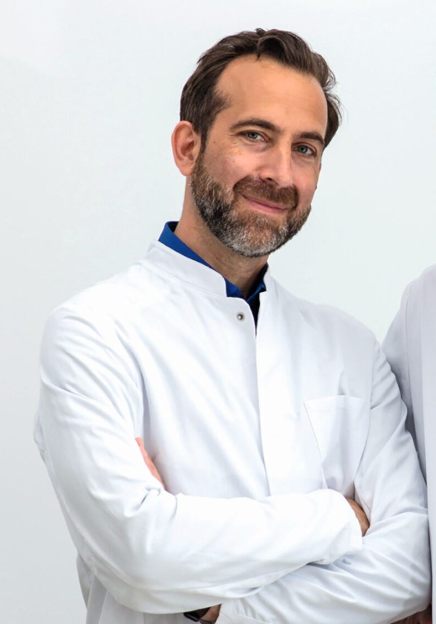Other Treatment Methods

Corneal transplantation
The cornea is the crystal-clear, tear-moistened front part of the eye. Diseases of the cornea often lead to a loss of transparency, so that affected individuals can only see very poorly with the otherwise healthy eye. The cornea is the most refractive medium in the optical system of the human eye. Even the smallest change in the cornea can therefore have dramatic consequences.
Scars from inflammation or injuries as well as progressive diseases such as keratoconus, which leads to thinning and conical deformation of the cornea of the eye, can often only be treated by ophthalmologists through transplantation of healthy human tissue in addition to degenerative diseases of the cornea.
Procedure of a corneal transplant
In a transplant In corneal replacement, the ophthalmologist replaces the patient's diseased corneal tissue with healthy tissue from a deceased organ donor. So-called corneal banks mediate suitable transplants.
Surgical techniques for corneal transplantation
Basically, two forms of transplantation can be distinguished: the classic perforating (penetrating) keratoplasty (transplantation of all layers of the cornea) and lamellar keratoplasty (transplantation of selected layers). Compared to perforating techniques, lamellar techniques are gentler. In addition, valuable healthy corneal layers of the recipient can be preserved. However, these techniques are not always feasible or meaningful.
Classic perforating keratoplasty (pKP)
The most proven and most frequently performed form of corneal transplantation is classic perforating keratoplasty. In this process, the ophthalmologist replaces the central part of the patient's diseased cornea with a transplant and sews it in place. The threads used are thinner than a human hair and are among the finest used in medicine The threads are left in place for up to a year and then gradually removed.
Lamellar keratoplasties
These techniques are currently experiencing a renaissance due to technical innovations and new surgical techniques. Experts differentiate between the anterior (front) lamellar and the posterior (back) lamellar transplantation.
Deep anterior lamellar keratoplasty (DALK)
This technique is only applicable if the two inner layers of the cornea, the Descemet's membrane and the precious corneal endothelium, are healthy. Ophthalmologists often use the DALK technique for keratoconus or scarring of the front layers of the cornea. Here, only the front two-thirds of the cornea are affected by changes, so the surgeon does not need to fully open the eye. The risk during the procedure, the healing time, and the risk of rejection are lower than with pKP. The femtosecond laser can be used as a supplement in DALK.
Posterior lamellar keratoplasty (DMEK)
The technique is one of the most demanding, but also gentlest procedures in transplant surgery alongside DALK. The transplant consists of the two innermost layers, the Descemet's membrane and the corneal endothelium. Eye surgeons primarily use the procedure for diseases of the corneal endothelium. In contrast to pKP and DALK, the technique does not require stitches. A bubble of air is sufficient for the surgeon to position the transplant. If the transplantation does not succeed, a DMEK can be repeated. The option of pKP is also still available.
Before the keratoplasty surgery
Before the procedure, the surgeon must first determine which parts of the cornea are affected by changes and which procedure is best suited for this patient suitable. The decision for a corneal transplant should be carefully considered, as it means an intensive and long-term relationship with the ophthalmologist. The goal of the transplant is to improve the optical clarity of the cornea. Once this is achieved, refractive errors that limit vision must be treated with intraocular lenses, contact lenses, or glasses.
Procedure of the corneal transplant
The surgery is performed on an outpatient basis under local anesthesia and sedation ('twilight sleep') and lasts 90 to 120 minutes.
Traditional penetrating keratoplasty
Using a scalpel or a femtosecond laser, the ophthalmologist prepares a corneal disc approximately 8 millimeters in diameter from the donor tissue. Then he removes a similarly sized disc from the recipient's eye. After that, he sutures the remaining tissue of the recipient with the donor tissue.
Corneal transplant with the femtosecond laser
Doctors also use this modern technology in corneal transplants. They refer to two different tissues: the patient's diseased corneal tissue (recipient) and the healthy tissue of the donor. Ophthalmologists use the Femtosecond laser for the preparation of both tissues. The precision of this technology in the field of corneal transplantation remains unmatched to this day. Patients also benefit from the procedure: vision and the patient recover more quickly after the operation than with conventional procedures.
Lamellar keratoplasty
Deep anterior lamellar keratoplasty (DALK) In this technique, the eye surgeon uses a scalpel or a femtosecond laser to make a vertical, non-penetrating circular cut (diameter about 8 mm) so that the healthy inner layers of the recipient's cornea are preserved. With the help of an air injection into the lower third of the cornea, they separate the healthy and diseased layers. The doctor prepares the donor tissue in a similar way to sew the inserted transplant into the recipient's tissue.
Posterior lamellar keratoplasty (DMEK)
For the DMEK, the ocular surgeon first carefully removes the Descemet's membrane-endothelial complex to be transplanted from the donor cornea. The transplant is only 30 microns thick, extremely fragile, and is placed into the recipient's eye by the doctor without touching it, using fluid exchange. Beforehand, the surgeon has removed the diseased inner corneal layers in the recipient's eye. Using an air bubble, they attach the transplant to the recipient's tissue.
Risks of corneal transplantation
As with all eye surgeries, the risk of infection is a primary concern. In transplants, there is also the risk of graft failure or rejection of the foreign tissue. However, corneal transplantation is one of the most successful tissue transplants in medicine, because the corneal tissue is not directly connected to the blood supply and thus the immune system. A strong immunosuppressive drug is usually not necessary.
After the operation
After the operation, the eye surgeon applies a sterile bandage, which they remove the next day during the postoperative check-up. The first days and weeks after the operation the eye may tear up more frequently and be reddened. Often there is a strong sensitivity to light and a foreign body sensation. The removal of sutures will be considered by the ophthalmologist, depending on the technique, no earlier than six months; however, they usually do this only after a year. After healing and suture removal, the doctor will work with the patient to improve refractive power and thus visual acuity.
Experts for this Treatment Method

- Modern Ophthalmology
Dr. med. Ilya Kotomin
Smile Eyes Leipzig
- Modern Ophthalmology
Priv.-Doz. Dr. med. Daniel Pilger
Smile Eyes Berlin
- Modern Ophthalmology
Raphael Neuhann (FEBO)
Opthalmologikum Dr. Neuhann / Augentagesklinik am Marienplatz
- Modern Ophthalmology
Dr. med. Tabitha Neuhann
Opthalmologikum Dr. Neuhann / Augentagesklinik am Marienplatz
- Modern Ophthalmology
Prof. Dr. med. Tanja M. Radsilber
Augenzentrum Prof. Dr. med. Holzer & Prof. Dr. med. Rabsilber
- Modern Ophthalmology
Dr. med. Karsten Klabe
Breyer, Kaymak & Klabe AugenchirurgieAll Experts in this Department
Show All
- Modern Ophthalmology
Dr. Mirka R. Höltzermann
Augenpraxis Dr. Höltzermann, Dr. von Schnakenburg, Augenpraxis Dres. Höltzermann & von Schnakenburg
- Modern Ophthalmology
Dr. med. Ilya Kotomin
Smile Eyes Leipzig
- Modern Ophthalmology
Priv.-Doz. Dr. med. Daniel Pilger
Smile Eyes Berlin
- Modern Ophthalmology
Raphael Neuhann (FEBO)
Opthalmologikum Dr. Neuhann / Augentagesklinik am Marienplatz
- Modern Ophthalmology
Dr. med. Tabitha Neuhann
Opthalmologikum Dr. Neuhann / Augentagesklinik am Marienplatz
- Modern Ophthalmology







